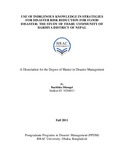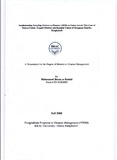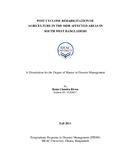Use of indigenous knowledge in strategies for disaster risk reduction for flood disaster: the study of Tharu community of Bardiya district of Nepal
Abstract
The main aim of this study was to explore the use of indigenous knowledge and practices
in Tharu Community to reduce the impact of flood disasters. Disasters are more frequent
and prominent at the present. Nepal is not an exception either. When the disaster strikes,
it is poor and marginalized groups that suffer the most. Tharu Community in Nepal is one
of the marginalized and vulnerable communities for flood hazards. Hence it is crucial to
increase the understanding about the ways which impacts of extreme events can be
reduced.
To carry our Disaster Risk Reduction approaches, it is first required to understand what
community needs. Promotion of new risk reduction options needs to consider local
tradition and norms to ensure their acceptability by the local people. In spite of huge
investments in the area of disaster management, losses continue to mount. The need to
bridge the gap between practice and policy with the recognition of indigenous knowledge
and local coping strategies is the must. Hence this paper is an attempt to understand the
local practices used by Tharu Community.
The research showed that the community people did have knowledge regarding the
changing climate and are putting their own efforts in order to cope up. They have their
own ways of forecasting and early warning systems. They are using the traditional ways
of embankment in order to minimize the adverse effects of flood. However, the indigenous
practices which proved to be useful in the past years were not enough to cope with the
rapid change in climatic patterns. Need to integrating scientific strategies in these
indigenous practices is a must.
Description
This dissertation is submitted in partial fulfillment of the requirements for the degree of Master in Disaster Management, 2011.Department
Department of Architecture, BRAC UniversityType
DissertationCollections
Related items
Showing items related by title, author, creator and subject.
-
Implementing standing orders on disaster (SOD) at Union level: the case of Kakua Union, Tangail district and Kazipur Union of sirajganj district, Bangladesh
Rashid, Mohammad Harunor (BRAC University, 2008-09)Bangladesh is arguably the world's most disaster prone country. Repeated disasters destroy the economic resource base of the poor people and drain out the economic potentials. The impacts and vulnerabilities of disasters ... -
Role of ICT in natural disaster management of Bangladesh
Md Hassan, Abu Ayub (BRAC University, 2015)Bangladesh being world's eighth-most populous country is highly vulnerable to recurrent natural hazards due to its location and topography. It regularly experiences floods, droughts, tornadoes and cyclones. Being located ... -
Post cyclone rehabilitation of agriculture in the Sidr affected areas in South West Bangladesh
Biswas, Ratan Chandra (BRAC University, 2011)Bangladesh is one of the most disaster prone countries of the world. Every year the country is experiencing one or more natural disasters like cyclone and flood. Bangladesh is an agricultural country. But unfortunately ...




